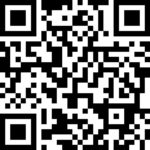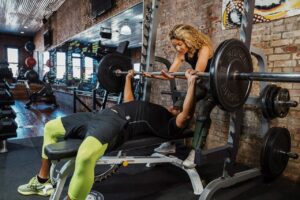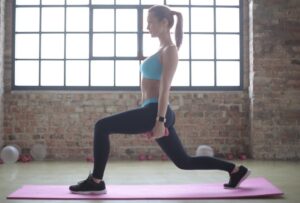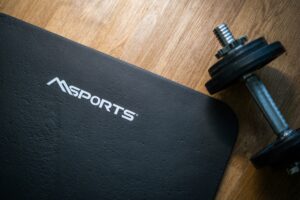Do you train your biceps consistently but feel that your workouts don’t produce the desired results? Your biceps are certainly not small or weak, but they look somehow incomplete.
If that’s the case, you might be making the significant but common mistake of over-emphasizing the short bicep head and not giving the long head enough attention. As a result, your biceps grow to a degree but fail to turn into the prominent and head-turning cannonballs you want.
Luckily, a simple way to fix it is to incorporate more long head bicep exercises. Today’s guide outlines 15 fantastic activities you can include in your bicep routine. We’ve also broken down the bicep anatomy and how to train the muscle effectively.
Let’s discuss.
What is the Long Bicep Head?
As its name suggests, the biceps brachii has two parts: a short and a long head (1). The two bicep heads run parallel to one another and work together to produce elbow flexion (bending of the arm) and wrist supination (outward rotation of the hand) (1).
The short head makes up the inner portion of the bicep, and developing it contributes to thickness (1). In contrast, the long head is located on the outer side and is responsible for the bicep peak when you flex your arm.
Aside from the bicep, there is another muscle called the brachialis (2). It lies underneath the bicep, and only a tiny portion of the muscle is visible in people who are lean enough. The portion lies on the outer part of the upper arm, located between the biceps and triceps.
The brachialis assists elbow flexion and develops alongside the bicep (2). It primarily works on activities that emphasize the long bicep head.
Any bicep exercise you perform will train both heads, but several factors determine which head works more.
Try the Hevy app and track your bicep workouts to see how you are progressing.
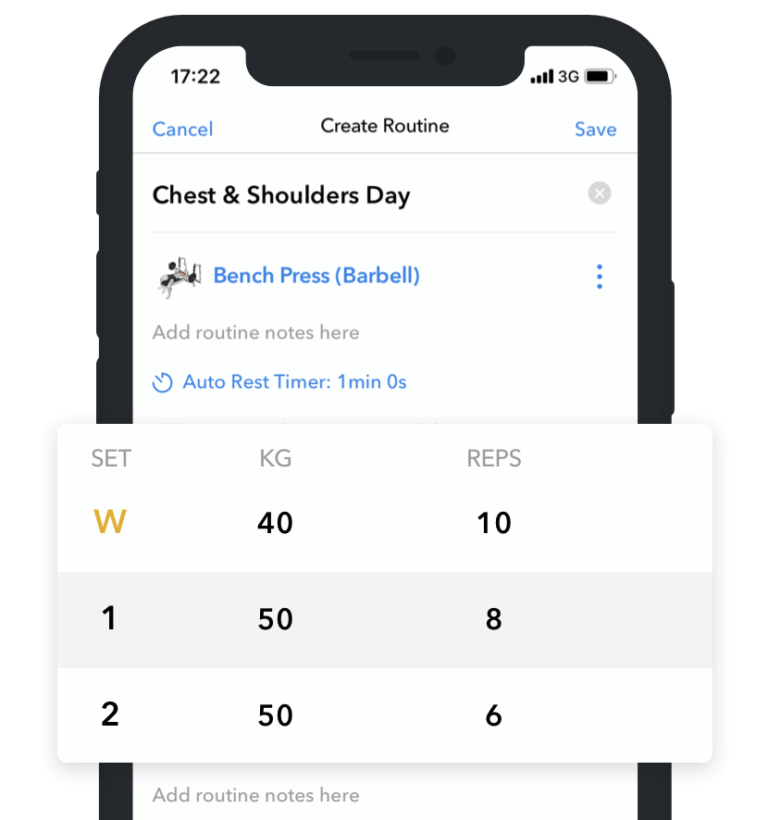
Hevy – Workout Tracker





Hevy – Workout Tracker
Create your own long head bicep workout with Hevy, and track your progress – for free
How to Target the Long Head of the Biceps Brachii
Several primary factors influence bicep activation and determine which head works more.
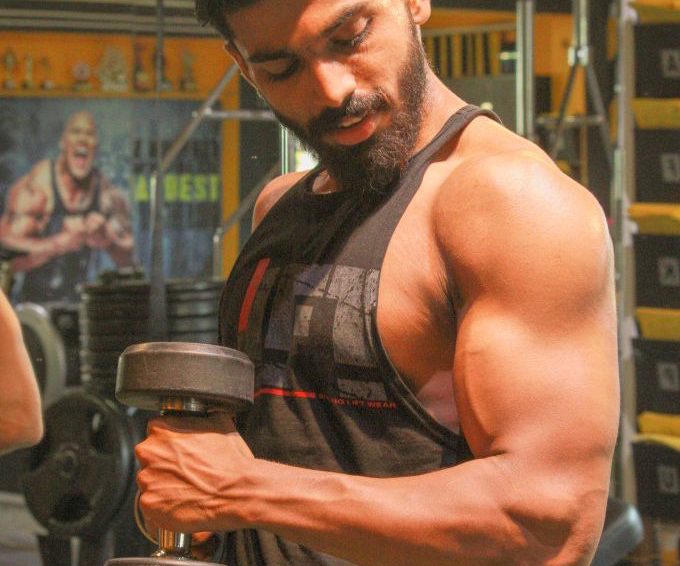

1. Grip Width
The first and most practical way to emphasize the long bicep head is to use a narrow grip on bilateral exercises. For example, keep your hands close when doing bicep curls with a straight or EZ bar.
Doing so is necessary because it angles your forearms across your body and places the long bicep head at a mechanical advantage. In contrast, using a wider grip turns your forearms away from your body, emphasizing the short head of the bicep.
2. Wrist Angle
As mentioned above, one of the bicep functions is to cause wrist supination––an outward wrist rotation that moves your hand into a palm-up position. The more supinated your wrists are, the more you target the short head of the biceps.
In contrast, having your hands in a more pronated position (facing down) emphasizes the long bicep head.
3. Arm Position
Another way to target the long head of the bicep is by tweaking your arm position in relation to your body. Having your arms in front of your body allows you to emphasize the short head. In contrast, bringing your arms back stretches the bicep and works the long head.
Bringing your arms back allows you to train the long head better because it attaches higher on the scapula (1). As such, the further back your arms are, the better your chances of stretching that portion of the biceps.
4. Exercise Selection
The final thing that determines bicep activation is your exercise selection. Some exercises are better suited to target one head, and including more long head biceps exercises is necessary for developing balanced muscles.
Speaking of exercises, let’s overview the 15 long head bicep exercises you can pick from to develop the outer portion of your biceps.
We’ve broken down the following list of long head bicep exercises based on the equipment needed. For instance, the first category is for exercises you can do with dumbbells. The one after that will require a straight bar, standard barbell, or EZ bar. We’ve also listed fantastic exercises for the long head you can do on various gym machines or with a cable.
Bicep Long Head Exercises With Dumbbells and Kettlebells
1. Dumbbell Hammer Curls
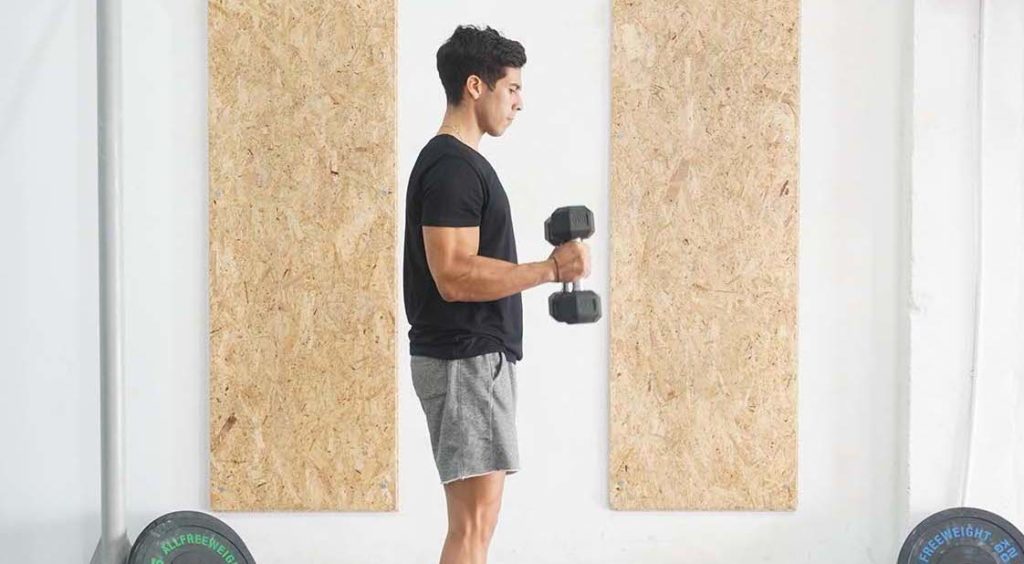

Your hands are neutral (in the middle between pronated and supinated) during dumbbell hammer curls, allowing you to more effectively target the long bicep head and the brachialis.
Having your hands neutral is also beneficial for targeting the brachioradialis––a forearm muscle that runs from the elbow joint to the wrist and assists with elbow flexion (3, 4).
How to do it (step-by-step):
- Grab a pair of dumbbells and stand tall with your feet shoulder-width apart and knees slightly bent.
- Position your arms to your sides with palms facing your body.
- Bring your shoulders back, engage your midsection, and squeeze your glutes.
- Take a breath and curl the dumbbells using only your biceps. Keep your elbows steady and to your sides.
- Lift the dumbbells until your wrists are slightly higher than your elbows, and hold for a moment.
- Lower the weights slowly and extend your arms as you exhale.
- Take another breath and repeat.
Tips/tricks:
- You can also do hammer curls with a resistance band. Grab a looped band with a neutral grip, step over it, and perform curls.
- Do the exercise seated if you struggle to maintain proper technique and swing your body too much.
Related: Back and Bicep Workouts for Building Strength
2. Cross-Body Hammer Curls
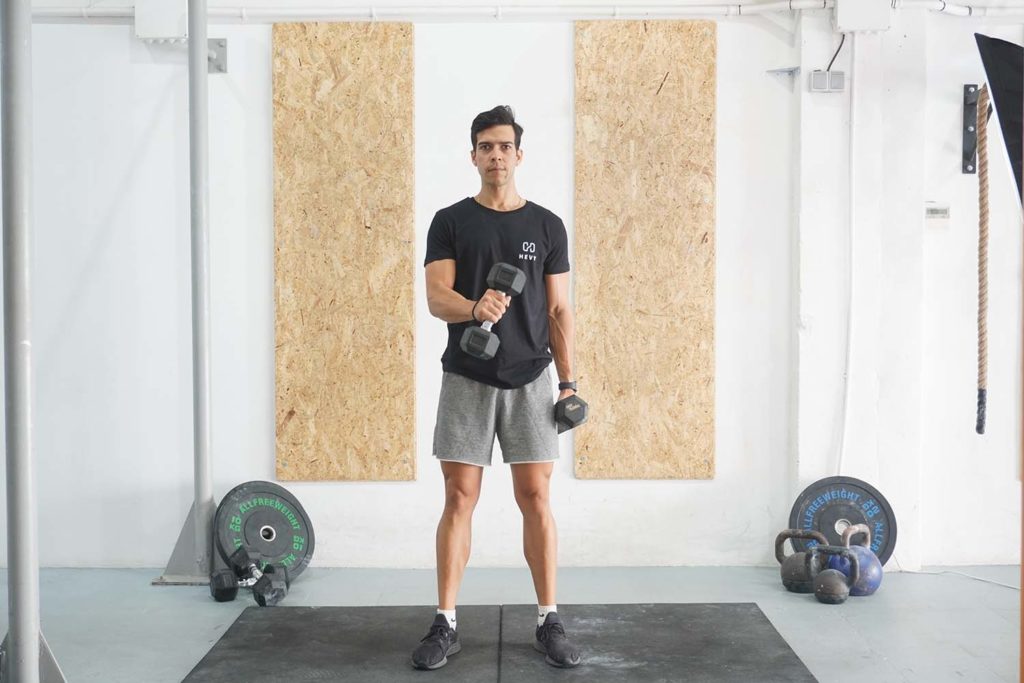

Cross-body hammer curls are a variation you perform by lifting the weights across your upper body. Doing so can help you further emphasize the long bicep head by putting it at a mechanical advantage.
Like hammer curls, the exercise is excellent for training the brachialis and brachioradialis. You can also use slightly more weight and cause a more significant overload because the dumbbells remain close to your center of gravity.
How to do it (step-by-step):
- Grab a pair of dumbbells and stand tall with your arms to your sides and palms facing your body.
- Position your feet comfortably and bend your knees slightly.
- Bring your shoulders back, squeeze your glutes, and take a breath.
- Curl one dumbbell across your body and toward your sternum.
- Lift the weight until your wrist is slightly higher than your elbow, and hold for a moment.
- Lower the dumbbell slowly, extending your arm fully. Exhale on the way down.
- Take another breath and lift the opposite dumbbell in the same way.
- Alternate between the left and right until you complete the set.
Tips/tricks:
- You can lean forward slightly by bending at the hip to create room if you use larger dumbbells.
- You can perform cross-body hammer curls with a resistance band. Take a band with the correct resistance level, step over it, and hold the opposite end close to your body. Once in position, curl across your body similarly to how you would when using a dumbbell.
3. Seated Incline Hammer Curls
The seated incline curl is one of the best long head biceps movements.
As discussed earlier, having your arms behind your body is beneficial for targeting the long head of the bicep. The position allows you to stretch the long head more effectively and provide the necessary growth stimulus.
Combining the arm position with a neutral wrist position further trains the outer portion of your biceps and brachialis. Incline dumbbell curls also train the long head, but the variation emphasizes the short head due to wrist position.
How to do it (step-by-step):
- Set an adjustable gym bench at a 60 to 75-degree incline (almost upright).
- Grab a pair of lighter dumbbells and sit on the bench.
- Place your arms to your sides with palms facing the gym bench.
- Lean back and retract your shoulder blades into the back support.
- Engage your abs and take a breath.
- Curl both dumbbells until your wrists are slightly higher than your elbows, and hold for a moment.
- Extend your arms slowly and exhale.
- Take another breath and repeat.
Tips/tricks:
- Keep your shoulder blades in contact with the back support throughout the set.
- Start with a pair of light dumbbells and do repetitions slowly to train your biceps effectively and avoid a shoulder injury.
Related: 2 Effective Dumbbell Bicep Workouts to get Large Muscular Arms
4. Reverse Dumbbell Curls
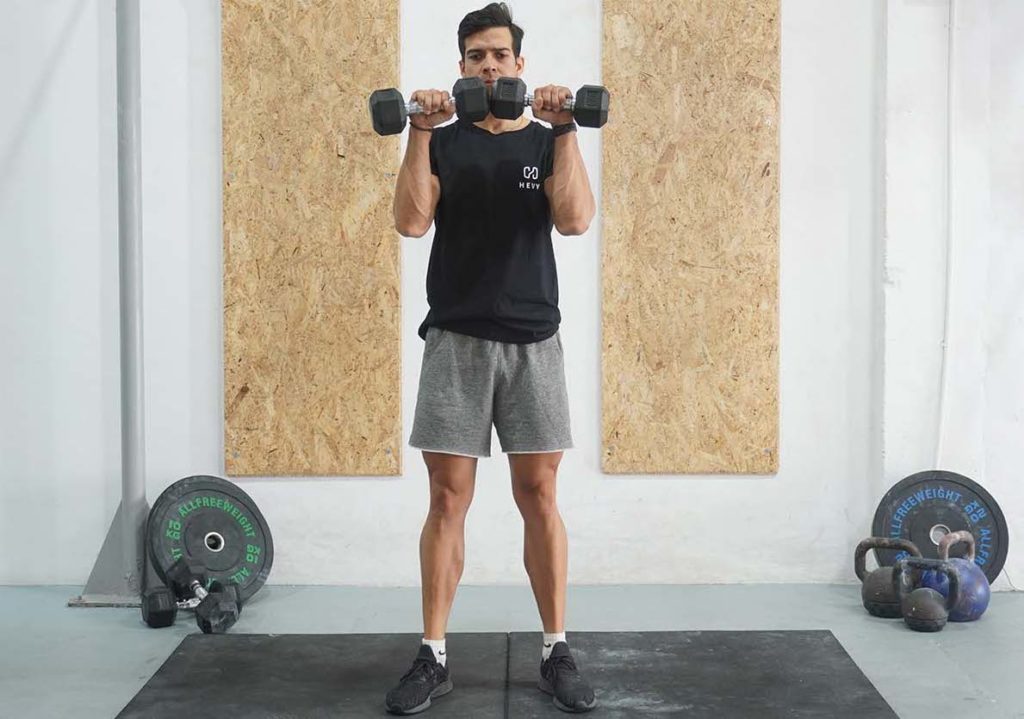

Reverse dumbbell curls are an exercise where you hold the weight with your palms down. Most people consider the reverse curl a forearm exercise, but it also works the long head of the biceps brachii and brachialis.
Curling the weight with your palms facing down prevents the short head from contributing.
How to do it (step-by-step):
- Grab a pair of dumbbells and stand tall with your arms to your sides and palms facing back.
- Bring your shoulders back and take a breath.
- Curl both dumbbells up until your wrists are slightly higher than your elbows.
- Hold the top position for a moment and extend your arms slowly as you exhale.
Tips/tricks:
- You can perform the exercise with a resistance band. Grab the band evenly with both hands and step over it to create an anchor point. Take a breath and curl like you would when using dumbbells.
- A common tendency is lifting your elbows as you do a reverse curl. Avoid that by anchoring your elbows to your sides and only using your biceps to lift the weight.
5. Zottman Curl
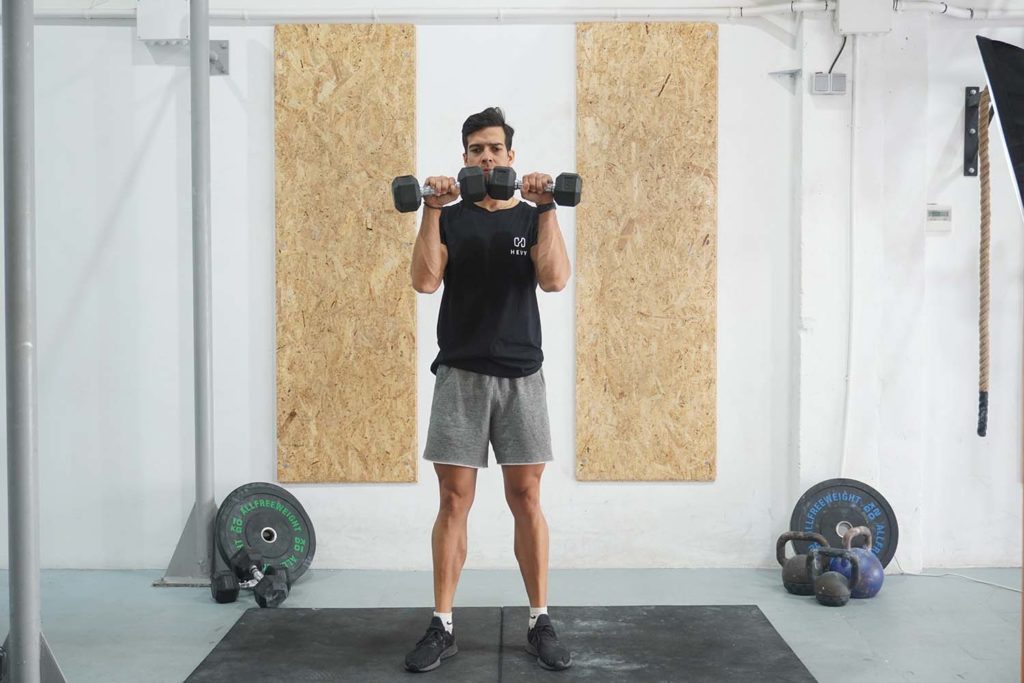

The Zottman curl is named after George Zottman, an American strongman. He popularized the exercise in the 1890s and attributed his remarkable arm growth to the movement.
Zottman curls are similar to reverse curls, aside from one difference. The objective is to start with your palms facing up but rotate them 180 degrees as you reach the top of the curl. A wrist rotation allows you to train the entire bicep on the way up and switch the emphasis to the long head and forearm on the way down.
How to do it (step-by-step):
- Grab a pair of dumbbells and stand tall. Have your feet in a comfortable stance, arms to your sides, and palms facing forward.
- Bring your shoulders back and take a breath.
- Curl both dumbbells until your wrists are slightly higher than your elbows.
- As you get close to the top, rotate your wrists 180 degrees and have your palms face the floor.
- Extend your arms with the pronated wrist position and rotate your wrists to their starting position as you exhale.
- Take another breath and repeat.
Tips/tricks:
- Pick a lighter weight because the exercise is challenging and takes time to master.
- Perform repetitions slowly to have enough time for the wrist rotations at the top and bottom.
Related: 15 Best Long Head Bicep Exercises to Get Bigger Arms
6. Plate Curl
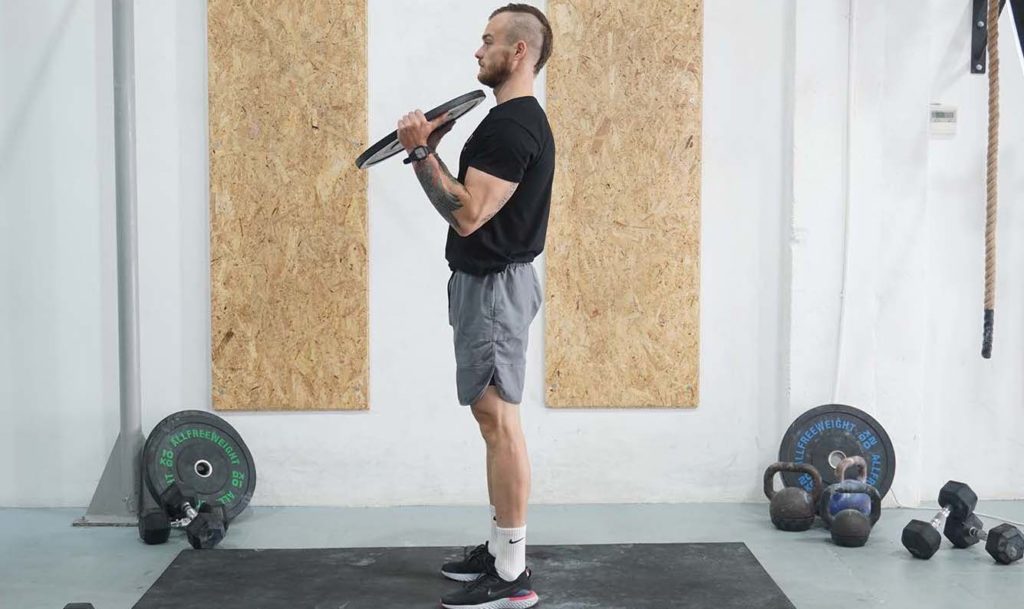

Plate curls are another simple and effective exercise for developing the biceps, brachialis, and brachioradialis. The movement is similar to hammer curls because you must hold a plate by its sides and use a neutral grip (palms facing one another).
A notable benefit of plate curls is that you can do a few good sets for your biceps even if you don’t have much available equipment.
How to do it (step-by-step):
- Grab a weight plate, but its sides and have your wrists neutral.
- Stand tall with your shoulders back, feet in a comfortable stance, and elbows to your sides.
- Take a breath and curl the plate, moving it up until your wrists are slightly higher than your elbows.
- Hold the contraction for a moment and extend your arms slowly, exhaling on the way down.
- Take another breath and repeat.
Tips/tricks:
- The plate curl is an excellent ‘finisher’ exercise. Once you’re done with your bicep workout, grab a plate you can curl for at least 12 reps and do a couple of sets close to muscle failure.
- You can also perform the movement on a preacher bench for extra support and to ensure proper technique.
7. Reverse Kettlebell Curl
The reverse kettlebell curl is another beneficial movement for the long head of the biceps and forearm musculature.
A notable benefit is that kettlebells are more compact than dumbbells and less likely to bump into your body when doing reverse curls.
How to do it (step-by-step):
- Grab a kettlebell and stand tall with your shoulders back and arms to your side. Your palm should face back.
- Take a breath and squeeze your glutes.
- Curl the kettlebell slowly, raising your wrist slightly higher than your elbow.
- Hold for a moment and extend your arm fully, exhaling on the way down.
- Repeat.
- Once finished, grab the kettlebell with your other hand and do the same number of reps.
Tips/tricks:
- You can grab the kettlebell handle with both hands and train both biceps simultaneously. Having your hands so close together further emphasizes the long bicep head and brachialis.
Long Head Bicep Exercises With a Barbell, Straight Bar, or EZ Bar (Best Bicep Peak Exercises)
8. Close-Grip Barbell Curls
Close-grip barbell curls are one of the best long head bicep exercises. The movement is good for developing a bicep peak because having your hands closer emphasizes the long head and brachialis.
In contrast, using a wider grip puts the short head of the bicep at a mechanical advantage, leading to better inner bicep development.
How to do it (step-by-step):
- Grab a barbell with an underhand grip and your hands slightly closer than shoulder-width apart.
- Stand tall with your shoulders back and feet in a comfortable stance.
- Take a breath and squeeze your buttocks.
- Curl the barbell until your wrists are slightly higher than your elbows, and hold for a moment.
- Extend your arms slowly as you exhale.
Tips/tricks:
- You can lean forward slightly to create enough room and train your biceps through a full range of motion. Being completely upright can stop you from extending your arms fully because your knuckles can run into your upper thighs.
- Aim for at least 10 reps and avoid going too heavy.
- Use an EZ bar instead of a barbell if you experience wrist discomfort.
9. Reverse EZ Bar Curl
Reverse EZ bar bicep curls are another fantastic movement that emphasizes the long head of the biceps along with the brachialis and brachioradialis.
Similar to other bicep exercises (e.g., Zottman curl, reverse-grip barbell curls, and reverse dumbbell curl), having your hands pronated (facing down) takes the emphasis away from the short bicep head.
How to do it (step-by-step):
- Grab an EZ bar with an overhand grip. Keep your hands a few inches apart.
- Stand tall, bring your shoulders back, and squeeze your glutes.
- Inhale and curl the bar slowly, squeezing your biceps at the top.
- Extend your arms slowly and breathe out.
10. Reverse Curl (Barbell)
Reverse barbell curls are similar to the EZ bar curl in several ways. Both have similar ranges of motion and train the long head of the biceps.
A notable difference is that holding a straight bar can lead to slightly better bicep activation for some people. It’s best to experiment and see which works better for you.
How to do it (step-by-step):
- Grab a barbell with an overhand grip. Have your hands shoulder-width apart or slightly narrower.
- Stand tall with your shoulders back.
- Squeeze your glutes and take a breath.
- Curl the barbell slowly and squeeze your biceps at the top.
- Extend your arms slowly and exhale.
Tips/tricks:
- Use a slightly wider grip if you experience wrist discomfort. Doing so might shift some of the emphasis to the short head, but you will still develop the outer portion of the bicep.
11. Barbell Drag Curls
Drag curls are an overlooked exercise for the long head of the biceps. The objective is to lift the weight in a straight line while keeping it in contact with your body.
The drag curl is similar to incline dumbbell curls because you must bring your arms behind your body, stretching the biceps in a similar way.
Consider using an EZ bar if a straight bar leads to wrist discomfort. The curved form allows you to keep your wrists in a slightly more advantageous position.
How to do it (step-by-step):
- Grab a barbell with an underhand grip and your hands shoulder-width apart or slightly wider. The ideal position for most people is having your hands just outside your thighs.
- Bring your shoulders back, engage your abs, and squeeze your glutes.
- Take a breath and curl the bar by dragging it against your body in a straight vertical line. Your elbows should move back, putting your biceps in a stretched position.
- Lift the bar as high as possible, squeezing your biceps at the top.
- Lower the bar in the same straight line and exhale.
Tips/tricks:
- The key to an effective drag curl is to keep the bar against your upper body throughout the entire set. You can also perform the movement with dumbbells.
Long Head Bicep Exercises With Cables and Gym Machines
12. Rope Cable Curls
-m_Forearms_small.jpg)
-m_Forearms_small.jpg)
Rope cable curls are one of the best long head bicep exercises, thanks to two unique benefits.
First, a cable machine provides constant tension, preventing your biceps from resting at any point during a set. Dumbbell curls are beneficial, but most of the tension occurs at the top, and your biceps don’t receive much stimulation at the bottom.
Second, using a rope allows you to keep your hands together and further activate the long head.
How to do it (step-by-step):
- Select the appropriate load, adjust the pulley to the lowest position, and attach a rope.
- Bend down and grab both ends of the rope evenly.
- Stand tall, keep your hands together, and maintain a neutral wrist position.
- Engage your abs and take a breath.
- Curl slowly until your wrists are slightly higher than your elbows.
- Hold the top for a moment and extend your arms as you exhale. You can lean forward a bit to create enough room for the full range of motion.
Tips/tricks:
- You can’t isolate the long head of the biceps but keeping your hands together emphasizes the outer portion of the muscle.
- Aim for at least 12 slow and controlled repetitions.
- You can involve the short head of the bicep by spreading the rope and bringing your forearms out at the top of each repetition.
13. Straight Bar Cable Curls
Straight bar cable curls are another helpful exercise for training the long head of the biceps. Like barbell curls, you must use a close grip with your forearms angled in to focus on the outer portion of the biceps.
In contrast, using a wider grip is beneficial for training the short head of the bicep.
How to do it (step-by-step):
- Pick the appropriate load, set the pulley in the lowest position, and attach a straight bar.
- Grab the bar with a double underhand grip (palms facing up) and stand up.
- Bring your shoulders back and squeeze your glutes.
- Take a breath and curl the bar, squeezing your biceps at the top.
- Release the weight slowly, extending your arms fully and exhaling.
Tips/Tricks:
- You can stagger your stance (bring one foot forward and the other back) to easily maintain your position. It can get challenging to stay upright when you start using more weight.
14. Straight Bar Cable Drag Curls
Cable drag curls are another excellent movement for training the long head of the biceps.
Adding the exercise to your bicep training is beneficial because cables provide constant tension, leading to better muscle activation.
How to do it (step-by-step):
- Select the appropriate load, set the pulley in the lowest position, and attach a straight bar.
- Bend over, grab the bar with a double underhand grip, and stand tall.
- Bring your shoulders back, position your elbows to your sides, and take a breath.
- Curl the bar, moving it in a straight line, and keeping it in contact with your body. Doing so will force your elbows to move back behind your body.
- Squeeze your biceps at the top and extend your arms slowly as you exhale.
Tips/tricks:
- You can attach a handle instead of a straight bar and train one bicep at a time. Doing so is beneficial for getting familiar with the exercise and learning to engage both biceps equally.
15. Bayesian Cable Curls
The bayesian curl is an overlooked, but incredibly beneficial long head biceps exercise that trains one arm at a time.
Bayesian curls resemble incline bench curls because your arms move behind your body, causing a fantastic long head bicep stretch. Plus, the cable provides constant tension, making these curls one of the best exercises for your biceps.
How to do it (step-by-step):
- Select a light load, set the pulley to the lowest position, and attach a handle.
- Face away from the pulley, squat down, and grab the handle with your right hand.
- Stand up and take a couple of steps forward, allowing your arm to move behind your body.
- Bring your shoulders back, engage your abs, and stagger your stance.
- Take a breath and curl, squeezing your bicep at the top. Keep your elbow behind your body.
- Extend your arm slowly and exhale.
- Once finished training one bicep, grab the handle with your other hand and do the same number of reps.
Tips/tricks:
- Bayesian bicep curls can’t isolate the long head of the biceps, but they come close and cause a good stretch. We recommend adding the exercise near the end of your bicep workout routine and doing at least 15 slow and controlled reps to achieve a great bicep pump.
Use a weightlifting tracker like Hevy to log and track all the exercises above.





Hevy – Workout Tracker





Hevy – Workout Tracker
Create your own long head bicep workout with Hevy, and track your progress – for free
Rep Ranges, Tempo, Rest Periods, and Other Details For Developing The Biceps
Aside from picking the correct long head biceps exercises, you must keep a few crucial details in mind for effective bicep training.
1. Rep Ranges
The bicep is a relatively small muscle and benefits from doing more reps, leading to better activation and a lower risk of ego lifting. Do no fewer than 10 reps on your heavier sets, but don’t be afraid to do 15, 20, or even 25+ reps on some sets, especially near the end of your workouts.
2. Tempo
Like any other muscle in your body, the biceps benefit from time under tension. Avoid rushing through repetitions but instead maintain a steady tempo, feeling your biceps work on each repetition.
3. Training Volume
According to research, our muscles need at least ten weekly sets to grow effectively (5). We recommend splitting your weekly training into two or three sessions to provide a more frequent growth stimulus, leading to superior hypertrophy.
4. Rest Periods
You should do at least 12 reps on most of your bicep sets, so keep your rest intervals between 90 and 120 seconds.
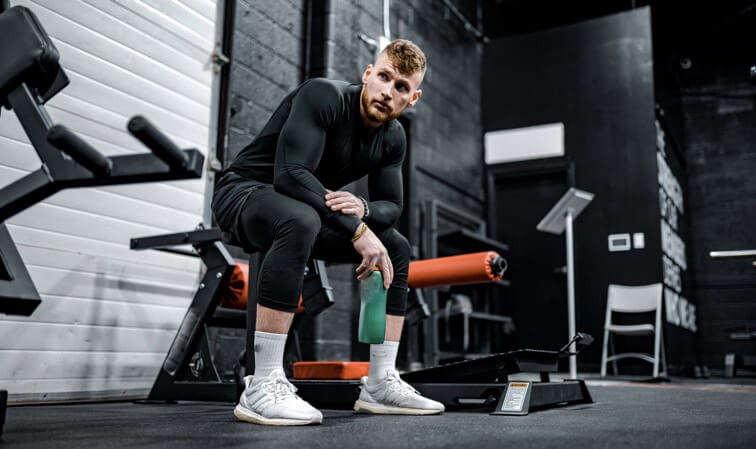

5. Range of Motion
A crucial mistake most trainees make is shortening the range of motion, which prevents them from stretching and contracting their biceps effectively. You should extend your arms and curl until your wrists are slightly higher than your elbows on almost all sets.
Well-Rounded Long Head Bicep Workout Routine (Bicep Peak Workout)
Let’s now go over two simple long head bicep workouts.
Long Head Bicep Workout Routine 1
| Exercise | Equipment | Sets | Reps | Rest Interval |
| Close-grip Barbell Bicep Curl | Barbell | 3 | 10 to 12 | 2 minutes |
| Incline Dumbbell Curls (Hammer Curl) | Dumbbells and an adjustable bench | 3 | 12 to 15 | 90 to 120 seconds |
| Bayesian Cable Curls | Cable machine | 3 | 15 to 20 | 90 seconds |
Long Head Bicep Workout Routine 2
| Exercise | Equipment | Sets | Reps | Rest Interval |
| Reverse EZ Bar Curl | EZ bar | 3 | 10 to 15 | 90 to 120 seconds |
| Zottman Curl | Dumbbells | 3 | 12 to 20 | 90 to 120 seconds |
| Rope Cable Curl | Cable machine | 3 | 15 to 25 | 60 to 90 seconds |
| Incline Dumbbell Curls (Hammer Curl) | Dumbbells and an adjustable bench | 2-3 | 15 to 25 | 60 to 90 seconds |
These are two great workout routines you can do for the long head of the biceps. For instance, you can do one of the bicep workouts after training back or chest and the second in combination with tricep exercises.
Do enough long head bicep exercises, and you will develop the bicep peak in no time.
Related articles:
- Bro Split – The Ultimate Workout Program Guide
- 5 Day Split Workout – The Complete Guide
- Incredible Tricep Dumbbell Workouts to Grow the Back of Your Arms
Check out the Buff Dudes Workouts video from youtube on the anatomy of the bicep and how to activate the long bicep head.
Final Words
The biceps are simple muscles to understand and train. Still, optimal development depends on more than picking a few random exercises and doing them a couple of times per week.
Building thick and wide biceps requires a systematic approach and a good exercise selection. Doing so is necessary for training the long head and the short inner portion of the biceps.
We’ve outlined 15 of the best long head you can pick from, along with best practices and a couple of sample routines. You don’t have to follow our workout routines, but we recommend using them as inspiration for how to put together a solid training plan and inflate your biceps.

